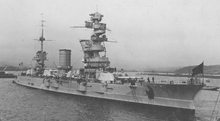Soviet Republic of Naissaar
| Soviet Republic of Soldiers and Fortress-Builders of Naissaar | ||||||||||
| Naissaare Nõukogude Vabariik | ||||||||||
| Unrecognized state | ||||||||||
| ||||||||||
|
| ||||||||||
| Capital | Obernargen (Söderby) | |||||||||
| Languages | Russian, Swedish, Estonian | |||||||||
| Government | Soviet republic | |||||||||
| Chairman¹ | Stepan Petrichenko | |||||||||
| Historical era | World War I | |||||||||
| • | Established | December 1917 | ||||||||
| • | Disestablished | 26 February 1918 | ||||||||
| Area | ||||||||||
| • | 1918 | 18.56 km² (7 sq mi) | ||||||||
| Population | ||||||||||
| • | 1918 est. | 300 | ||||||||
| Density | 16.2 /km² (41.9 /sq mi) | |||||||||
| Currency | "Kerensky ruble" (Keriniki) | |||||||||
| ||||||||||
| ¹ Chairman of the "Council of People's Commissars". | ||||||||||
The Soviet Republic of Soldiers and Fortress-Builders of Naissaar was a revolutionary state that during the First World War controlled the Estonian island of Naissaar (Swedish: Nargö; German: Nargen) in 1917–1918 for a brief period after the October Revolution and prior to the Occupation of Estonia by the German Empire.
History
On 5 November 1917, the October Revolution spread from Estonia to Russia. 28 November (15 November) 1917 the Maapäev (Provincial Diet) refused to recognize the new Bolshevik rule and proclaimed itself the supreme legal authority in Estonia. At the time, the most important fortification system in the area, called Peter the Great's Naval Fortress, was located at the narrowest point of Gulf of Finland. It included heavy coastal artillery batteries in the area of Estonia's capital Tallinn (Reval) and the nearby island of Naissaar. At the time, anarchosyndicalist Stepan Petrichenko was transferred to Tallinn.

In December 1917, the revolutionary sailors of the battleship Petropavlovsk took power on the small island of Naissaar and proclaimed an independent Soviet republic there. The Russian sailors, numbering about 80–90, formed the government. The Republic of Estonia formally declared independence on 23 February 1918, only to be forcibly occupied and annexed by the German Empire. Between February and November 1918, the Germans – who had already occupied the Estonian islands (Hiiumaa, Muhu and Saaremaa) in 1917 – also occupied Tallinn and the rest of Estonia, for the time being putting an end to both the Republican and the Soviet regimes. On 26 February 1918, the government of Naissaar evacuated from the island.

See also
- Kronstadt Commune
- Kronstadt rebellion
- Soviet Republic
External links
- Soviet Republic of Naissaar
- Soviet Republic of Naissaar
- Soviet Republic of Naissaar
- F.F. Raskolnikov, "Tales of Sub-Lieutenant Ilyin. A prisoner of the British"
- "Naissaar, Former Soviet Navy Base" (photographs with captions)
- Map of Naissaar (Estonian)
